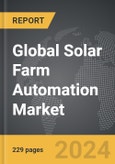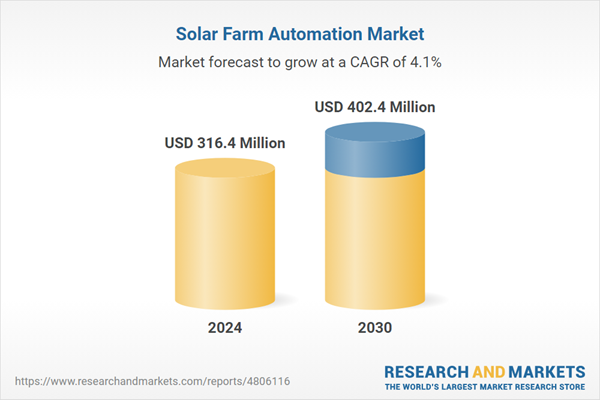The global market for Solar Farm Automation was valued at USD 316.4 Million in 2024 and is projected to reach USD 402.4 Million by 2030, growing at a CAGR of 4.1% from 2024 to 2030. This comprehensive report provides an in-depth analysis of market trends, drivers, and forecasts, helping you make informed business decisions.
Global Solar Farm Automation Market - Key Trends and Drivers Summarized
Solar Farm Automation: Is It Revolutionizing the Efficiency of Large-Scale Solar Energy Production?
Solar farm automation is becoming increasingly important in the solar energy industry as it enhances operational efficiency, reduces costs, and improves energy yield. With the expansion of large-scale solar farms worldwide, the need for automated systems that can manage, monitor, and optimize solar farm operations in real time is growing. Automated solutions such as robotic cleaning systems, AI-driven predictive maintenance, and remote monitoring are being widely adopted to reduce human intervention and operational downtime. The increasing focus on maximizing energy production, minimizing operational costs, and enhancing asset management is driving the adoption of solar farm automation technologies across utility-scale solar installations.How Are Technological Innovations Shaping the Solar Farm Automation Market?
Technological advancements in artificial intelligence (AI), Internet of Things (IoT), and robotics are significantly transforming the solar farm automation market. The integration of AI and machine learning algorithms in monitoring and maintenance systems allows for real-time data analysis, fault detection, and predictive maintenance, enabling solar farms to operate more efficiently and reliably. The use of drones and autonomous vehicles for solar panel inspection, cleaning, and maintenance is reducing labor costs and enhancing safety. Moreover, the development of digital twins and virtual power plants is optimizing solar farm operations by providing virtual models that simulate real-time scenarios, enabling better decision-making and performance optimization. These technological innovations are expanding the application scope of solar farm automation, supporting its growth in the renewable energy sector.Which Market Segments Are Leading the Growth of the Solar Farm Automation Industry?
Components include hardware, software, and services, with hardware holding the largest market share due to the increasing deployment of robotic cleaning systems, sensors, and drones in solar farms. Solutions are categorized into asset management, monitoring and control, predictive maintenance, and field operations, with monitoring and control leading the market due to the high demand for real-time data analysis and performance optimization. Applications of solar farm automation span utility-scale solar farms, distributed generation systems, and microgrids, with utility-scale solar farms being the dominant segment due to their large size and complexity. Geographically, North America and Europe are the largest markets for solar farm automation, driven by the early adoption of advanced technologies and increasing investments in solar energy infrastructure, while Asia-Pacific is expected to witness significant growth due to the rapid expansion of solar capacity and the need for efficient energy management.What Are the Key Drivers of Growth in the Solar Farm Automation Market?
The growth in the solar farm automation market is driven by several factors, including the rising adoption of renewable energy solutions, technological advancements in AI and robotics, and the increasing focus on enhancing solar farm efficiency and reducing operational costs. The need to optimize energy production, reduce maintenance costs, and improve asset management is driving the demand for automated solutions across utility-scale solar farms. Technological innovations in AI-driven predictive maintenance, remote monitoring, and digital twin technologies are enhancing the efficiency and reliability of solar farm operations, supporting market growth. The expansion of large-scale solar projects, the growing emphasis on grid integration and energy storage, and the increasing use of drones and autonomous vehicles for solar farm management are creating new opportunities for market players. Additionally, the focus on reducing human intervention, enhancing safety, and achieving sustainable energy goals is further propelling the growth of the solar farm automation market.Report Scope
The report analyzes the Solar Farm Automation market, presented in terms of market value (USD Thousand). The analysis covers the key segments and geographic regions outlined below.Segments
Type (Solar Tracker, Distributed Control System (DCS), Supervisory Control and Data Acquisition (SCADA), Programmable Logic Controller (PLC), Other Types).Geographic Regions/Countries
World; United States; Canada; Japan; China; Europe (France; Germany; Italy; United Kingdom; and Rest of Europe); Asia-Pacific; Rest of World.Key Insights:
- Market Growth: Understand the significant growth trajectory of the Solar Tracker segment, which is expected to reach $250.7 Million by 2030 with a CAGR of a 3.3%. The Distributed Control System (DCS) segment is also set to grow at 4.4% CAGR over the analysis period.
- Regional Analysis: Gain insights into the U.S. market, valued at $85.1 Million in 2024, and China, forecasted to grow at an impressive 3.7% CAGR to reach $63.4 Million by 2030. Discover growth trends in other key regions, including Japan, Canada, Germany, and the Asia-Pacific.
Report Features:
- Comprehensive Market Data: Independent analysis of annual sales and market forecasts in USD from 2024 to 2030.
- In-Depth Regional Analysis: Detailed insights into key markets, including the U.S., China, Japan, Canada, Europe, Asia-Pacific, Latin America, Middle East, and Africa.
- Company Profiles: Coverage of major players such as ABB Group, Abengoa Solar SA, AllEarth Renewables, DEGERenergie GmbH & Co. KG, Emerson Electric Company and more.
- Complimentary Updates: Receive free report updates for one year to keep you informed of the latest market developments.
Why You Should Buy This Report:
- Detailed Market Analysis: Access a thorough analysis of the Global Solar Farm Automation Market, covering all major geographic regions and market segments.
- Competitive Insights: Get an overview of the competitive landscape, including the market presence of major players across different geographies.
- Future Trends and Drivers: Understand the key trends and drivers shaping the future of the Global Solar Farm Automation Market.
- Actionable Insights: Benefit from actionable insights that can help you identify new revenue opportunities and make strategic business decisions.
Key Questions Answered:
- How is the Global Solar Farm Automation Market expected to evolve by 2030?
- What are the main drivers and restraints affecting the market?
- Which market segments will grow the most over the forecast period?
- How will market shares for different regions and segments change by 2030?
- Who are the leading players in the market, and what are their prospects?
Some of the 11 major companies featured in this Solar Farm Automation market report include:
- ABB Group
- Abengoa Solar SA
- AllEarth Renewables
- DEGERenergie GmbH & Co. KG
- Emerson Electric Company
- Energia Ercam S.A.
- First Solar, Inc.
- General Electric Company
- Haosolar Co. Ltd
- Heliopower
- Honeywell International, Inc.
- Mecasolar (Mecanizados Solares S.L.)
- Mitsubishi Electric Corporation
- NEXTracker, Inc.
- Rockwell Automation, Inc.
- Siemens AG
- Trabant Solar Inc.
- Yokogawa Electric Corporation
Table of Contents
I. METHODOLOGYII. EXECUTIVE SUMMARY2. FOCUS ON SELECT PLAYERSIII. MARKET ANALYSISIV. COMPETITION
1. MARKET OVERVIEW
3. MARKET TRENDS & DRIVERS
4. GLOBAL MARKET PERSPECTIVE
UNITED STATES
CANADA
JAPAN
CHINA
EUROPE
FRANCE
GERMANY
ITALY
UNITED KINGDOM
REST OF EUROPE
ASIA-PACIFIC
REST OF WORLD
Companies Mentioned (Partial List)
A selection of companies mentioned in this report includes, but is not limited to:
- ABB Group
- Abengoa Solar SA
- AllEarth Renewables
- DEGERenergie GmbH & Co. KG
- Emerson Electric Company
- Energia Ercam S.A.
- First Solar, Inc.
- General Electric Company
- Haosolar Co. Ltd
- Heliopower
- Honeywell International, Inc.
- Mecasolar (Mecanizados Solares S.L.)
- Mitsubishi Electric Corporation
- NEXTracker, Inc.
- Rockwell Automation, Inc.
- Siemens AG
- Trabant Solar Inc.
- Yokogawa Electric Corporation
Table Information
| Report Attribute | Details |
|---|---|
| No. of Pages | 229 |
| Published | March 2025 |
| Forecast Period | 2024 - 2030 |
| Estimated Market Value ( USD | $ 316.4 Million |
| Forecasted Market Value ( USD | $ 402.4 Million |
| Compound Annual Growth Rate | 4.1% |
| Regions Covered | Global |









